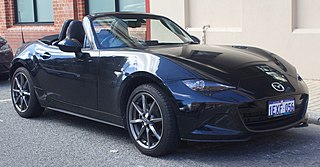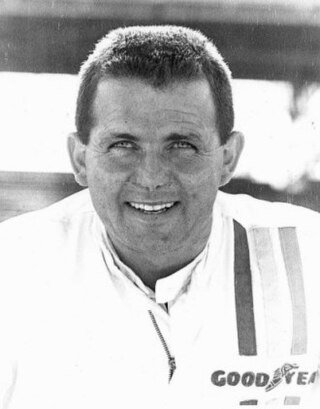
A roadster is an open two-seat car with emphasis on sporting appearance or character. Initially an American term for a two-seat car with no weather protection, usage has spread internationally and has evolved to include two-seat convertibles.

Rodger Morris Ward was a World War II P-38 aviator in the United States Army Air Forces, and an American race driver with 26 victories in top echelon open-wheel racing in North America, two Indianapolis 500 victories, and two USAC National Championships, who conceived the classic tri-oval design and layout of Pocono International Raceway, modeled after his three favorite signature turns, at Trenton, Indianapolis and Milwaukee.

Troy Lynn Ruttman was an American race car driver. He was the older brother of Jimmy Ruttman, and NASCAR driver Joe Ruttman.
John James McGrath was an American racecar driver. McGrath died in an accident at Bobby Ball Memorial, he lost control of his car at Turn 3, crashed and flipped, dying instantly.
Dempsey Cothrin Wilson was an American racecar driver.
Edward Julius Sachs Jr, was a United States Auto Club driver who was known as the "Clown Prince of Auto Racing". He coined the phrase "If you can't win, be spectacular".

James Hurtubise was an American race car driver who raced in USAC Champ Cars, as well as sprint cars and stock cars. He was from the Buffalo suburb of North Tonawanda, New York. Hurtubise enjoyed a lot of success in sprint cars, champ dirt cars, and stock cars, but never achieved the success at the Indy 500 that his rookie qualifying run promised when he out qualified pole sitter Eddie Sachs by three mph, nearly breaking the 150 mph mark. "Herk" was a fan favorite throughout much of his career because of his fun-loving attitude and his hard driving style.

A. J. Watson was a car builder and chief mechanic from 1949 through 1984 in the Indianapolis 500, winning the race six times as a car builder. Rodger Ward won 18 races driving Watson cars.

David George MacDonald was an American road racing champion noted for his successes driving Corvettes and Shelby Cobras in the early 1960s. At the age of 27, he was killed in the 1964 Indianapolis 500, along with fellow driver Eddie Sachs. In his four-year racing career, MacDonald competed in 118 races with 52 victories and 75 top-three finishes.
This article discusses the year-by-year history of the Indianapolis 500 race.

Barrett-Jackson is an American collector car auction company headquartered in Scottsdale, Arizona. It was founded by Scottsdale business partners Tom Barrett and Russ Jackson. They initially launched a car show, Fiesta de los Autos Elegantes, in 1967 to raise money for local facilities. The first Barrett-Jackson auction, originally meant as a one-time event, was held in December 1971. Due to its success, it became an annual event, eventually prompting the creation of other collector car auctions in the Scottsdale area.

The Lotus 38 was the first rear-engined car to win the Indianapolis 500, in 1965, driven by Jim Clark. It was run by Lotus at Indianapolis from 1965 to 1967; a total of 8 were built, most for use by Lotus, but several were sold for use by other drivers, including A. J. Foyt and Mario Andretti.

The Indianapolis Motor Speedway Museum is an automotive museum on the grounds of the Indianapolis Motor Speedway in Speedway, Indiana, United States, which houses the Indianapolis Motor Speedway Hall of Fame. It is intrinsically linked to the Indianapolis 500 and Brickyard 400, but it also includes exhibits reflecting other forms of motorsports, passenger cars, and general automotive history. In 2006, it celebrated its 50th anniversary. The museum foundation possesses several former Indianapolis 500 winning cars, and pace cars, and they are regularly rotated onto the display floor exhibits.

The third generation of the Ford Thunderbird is a personal luxury car produced by Ford for the 1961 to 1963 model years. It featured new and much sleeker styling than the second generation models. Sales were strong, if not quite up to record-breaking 1960, at 73,051 including 10,516 convertibles. A new, larger 390 cu in (6.4 L) FE-series V8 was the only engine available. The Thunderbird was 1961's Indianapolis 500 pace car, and featured prominently in US President John F. Kennedy's inaugural parade, probably aided by the appointment of Ford executive Robert McNamara as Secretary of Defense. It shared some styling cues with the much smaller European Ford Corsair.

The Lotus 29 was a British racing car built by Team Lotus for the 1963 Indianapolis 500. It was their first attempt at the event and the two cars which were entered finished second and seventh in the hands of Jim Clark and Dan Gurney. Although they were not the first rear-engined cars built for the category, they were first to prove that the configuration was definitely a potential race-winner, and that the days of the big and heavy front-engined roadsters were numbered.

Richard "Rick" DeBruhl is an American auto racing and automobile auction commentator. He is currently the TV voice of the Barrett Jackson collector car auctions on the A&E Networks. DeBruhl previously worked in radio before becoming a television personality and journalist for the NBC affiliate in Phoenix, Arizona. His motorsports work began on ESPN in 1988 and lasted for nearly thirty years.

Indianapolis 500 Evolution is a racing game, developed by British studio Brain in a Jar Ltd, based on the Indianapolis 500 and American Championship car racing from 1961 to 1971. It is similar to Destineer's 2007 game Indianapolis 500 Legends. In the game, players take on the roles of various famous racers from that time period with 21 missions, photos, and movies, as well as competing on courses such as the Indianapolis Motor Speedway, as well as the Milwaukee Mile, Trenton, Riverside, Hanford and Langhorne Speedway. Honey Creek, the name for inner road course of the Milwaukee Mile, is also included, and is still used for various club racing events in the present day.

The Cooper T54 is a rear-engined open-wheel race car chassis, designed, developed, and built by Cooper, for U.S.A.C. Indy car racing, between 1961 and 1963. It was powered by a 250 hp (190 kW) 2.75 L (168 cu in) Coventry Climax FPF four-cylinder, but later used an Aston Martin six-cylinder engine, installed by automotive mechanic and engineer Joe Huffaker, after the car had been by Jim Kimberly to Kjell Qvale. After competing in IndyCar racing, it competed in a variety of different motorsports, including sprint car racing, where it was powered by larger Ford, Buick, and Chevrolet V8 engines.

The Kurtis Kraft 500B, 500C, 500F, and 500G, are a series of open-wheel race cars, designed, developed and built by Kurtis Kraft, for AAA and U.S.A.C. Indy car racing, between 1948 and 1960. It was also notably the last front-engined car to win the Indianapolis 500, in 1964.
















